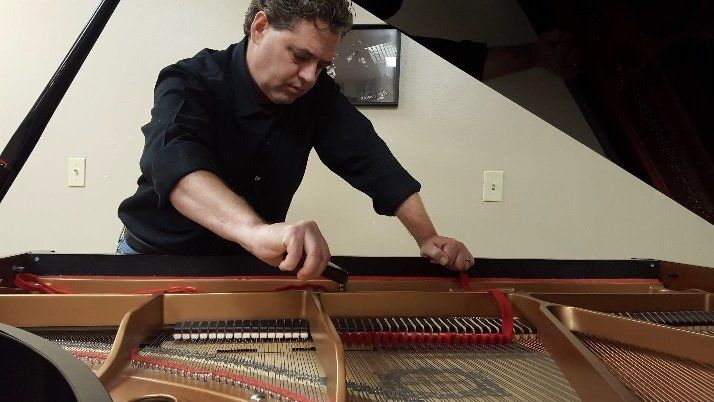Maintaining Your Piano
No matter if your piano is 50 years old or 5 years old, it is very important to have your piano tuned every 6 months. The reason; your piano WILL go out of tune and WILL need tuning, as there will be seasonal changes. In the dry months, your piano will go flat due to the wood (sound board) shrinking. In the humid months, the wood grain will expand, causing the piano to go sharp. What this means to you is that your piano just won’t sound right. In fact, it might be intolerable!
The 220+ piano strings are stretched to a tension of approximately 168 lbs. per string, causing enormous downward pressure on the bridges, which is transferred to the sound board. The sound board is the large piece of wood under the strings. It looks flat, but it's not. It’s actually rounded like an upside down bowl, higher in the middle of the sound board. If you look at the back of a guitar, cello, or violin, you will notice that the back side is rounded. The sound board in a piano is the same, only under a much greater amount pressure. In an upright piano, the total string tension is approximately 12 tons; in a grand piano, approximately 20 tons. With seasonal changes in humidity and temperature, the woods and metal expand and contract. This is what causes your piano to go out of tune.
It is therefore, very important to tune your piano every 6 months, especially living in Iowa. You may not notice that the piano has gone out of tune, because the tension may have changed evenly. The longer a piano goes without regular maintenance, the more it will cost in the long run. A quality piano will not sound good, and an older piano will only be worse. With proper maintenance every 6 months, you will extend the life of your piano, while enjoying the purity and harmonious tone your piano is capable of. This also allows for regular inspection of other components needing adjustment or repair, and issues concerning things like sticking keys, noises, and pedal adjustments.
When a piano goes for a long time without being regularly tuned, it’s likely that the piano will be extremely flat. When this happens, it’s usually required to tune the piano twice, sometimes three times, before the tuning will hold. The first pass is a rough tuning called a pitch raise, or pitch adjustment. This brings the total tension into the ball park of being close to pitch. The second pass is a fine tuning, allowing the sting tension to be equalized and the tuning pins set.
By maintaining the average temperature and humidity in the room where the piano lives, you will dramatically help prevent wide changes in piano pitch. Ideally, when the piano is tuned, there should be as little of movement of the tuning pins as possible. The rule of thumb is; the less the strings and pins have to move, the better.
It’s a good idea to purchase a digital hygrometer, which will tell you how the room behaves as far as humidity and temperature fluctuation. If it’s difficult to control, a humidifier system can be installed in your piano. Take care of your piano and it will take care of you!

